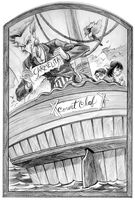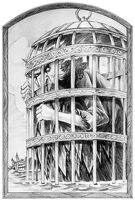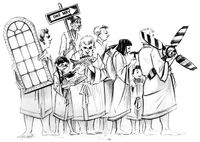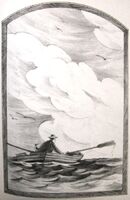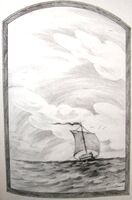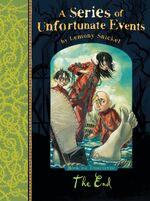The End is the thirteenth and final book (besides "Chapter Fourteen") in A Series of Unfortunate Events.
Plot Summary
The book opens with the Baudelaire orphans, Violet, Klaus and Sunny, and Count Olaf on a boat heading away from the Hotel Denouement. After a storm, the Baudelaires are welcomed on an island by a girl named Friday Caliban, while Count Olaf is shunned. The island facilitator, Ishmael, introduces the Baudelaires to the islanders and their customs.
Although Ishmael (He prefers Ish) always tells the islanders "I won't force you," it soon becomes apparent that his decisions go largely unquestioned and his suggestions are obeyed like orders. After the Baudelaires introduce themselves, Friday's mother, Miranda Caliban, toasts the "Baudelaire orphans" (despite them not mentioning their lost parents) with the coconut cordial which everybody carries, but which the Baudelaire orphans dislike.
After another storm, more objects wash up including a giant pile of books tied together in the shape of a cube, an unconscious and pregnant Kit Snicket, and the Incredibly Deadly Viper from Uncle Monty's collection. The island people arrive and Count Olaf tries to fool them with a bad Kit Snicket disguise (with the diving helmet containing the Medusoid Mycelium tucked under his dress as his supposed baby). Strangely, the islanders immediately see through Olaf's flimsy disguise and cage him. The islanders then debate whether the orphans should be expelled from the colony when Count Olaf yells out from the cage that they are carrying banned items in their pockets. Ishmael decides that the children, Kit, and Olaf should all be abandoned unless they agree to abide by the colony's rules. After everyone leaves, Olaf tries to tempt the children to let him out of the cage by promising to explain the many mysteries and secrets which they have been surrounded by since The Bad Beginning, but they ignore him.
That night, two of the islanders (Finn and Erewhon) sneak out to feed the children and ask them a favor. A group of discontented colonists are planning a mutiny against Ishmael in the morning, and they ask the Baudelaires to go over to the arboretum where all the contraband items are collected and find or make some weapons to use in the rebellion. Further, the mutineers refuse to help Kit unless the Baudelaires help them. The children agree, and set off for the arboretum. The orphans discover a well-appointed living area before they are discovered by Ishmael. They learn that their parents were once the island's leaders and were responsible for many improvements meant to make island-life easier and more pleasant, but they were eventually overthrown by Ishmael, who believed that a strictly-enforced simple life (combined with the opiate of the coconut cordial) was the best way to avoid conflict. The Baudelaires find an enormous history of the island, entitled A Series of Unfortunate Events, written by the many different people who had served as island leaders, including their parents and Ishmael. Ishmael also makes references to many other people, including a girl with only one eyebrow and ear (the mother of Isaac Anwhistle) and Gregor Anwhistle.
The Baudelaires and Ishmael go back to the other side of the island, where the mutiny is already underway. Count Olaf returns, still in disguise. After a brief exchange, Ishmael harpoons Olaf in the stomach, which shatters the helmet containing the Medusoid Mycelium, infecting the island's entire population at once. With Count Olaf slowly bleeding to death, the Baudelaires run back to the arboretum to try to find some horseradish to cure everyone. They learn that their parents had hybridized an apple tree with horseradish, allowing the fruit to cure the effects of the Medusoid Mycelium. The Incredibly Deadly Viper offers them an apple. After sharing the apple and curing themselves, they then gather more apples for the island's inhabitants, only to discover that the island people have abandoned the mutiny and boarded their outrigger canoe, ready to set sail. Ishmael refuses to allow the apples onboard, though it is clear that he himself has already eaten one to cure himself, and the boat sails away to a horseradish factory to save everyone (It is hinted that one apple might have been sneaked on board by the Incredibly Deadly Viper to tide them over until they reach the factory).
Kit tells the Baudelaires the fate of the Quagmires, Hector, Captain Widdershins and his two stepchildren Fernald and Fiona. After reuniting on Hector's float, they are attacked by trained eagles, who pop the balloons supporting the float and send them hurtling back to the ruins of the Queequeg. There, they are taken by the mysterious object shaped like a question mark (called "The Great Unknown" by the author). In turn, the Baudelaires confess their own crimes committed at the Hotel Denouement. At this point, Kit is about to go into labor. She seems to be dying of the fungus, but cannot eat the bitter apple due to the hybrid's unhealthy effects on unborn babies. She is still trapped on top of the cube of books (her Vaporetto of Favorite Detritus) but when the critically-injured and fungus-choked Olaf hears that she is still alive, he takes a bite of an apple and manages to get her safely down onto the beach, giving her a single soft kiss as he lays her on the sand and collapses, still conscious, beside her. Kit recites the poem "The Night Has a Thousand Eyes" by Francis William Bourdillon, answered by Olaf reciting the final stanza of Philip Larkin's "This Be The Verse". He then dies. The Baudelaires help Kit give birth to a baby girl. She then dies due to the Medusoid Mycelium, after asking the orphans to name the baby after their mother.
Chapter Fourteen
The book ends with an epilogue in the form of a short book titled "Chapter Fourteen" that begins one year later. Kit's baby and the Baudelaires sail away from the island on the boat they arrived to the island on to immerse themselves in the world once more. As they board the ship, Kit's baby says the boat's actual name, Beatrice, which is also her own name. In the last illustration of the book, the ocean's wave contains an outline of a question mark, or The Great Unknown. It means that it is unknown if the Baudelaires survive the journey back to the mainland or not.
Afterward
The book contains a notable continuity error, as the author states that he was unable to find any trace of the Baudelaires and therefore knows nothing of their fates. However, other earlier books by Lemony Snicket indicated that the Baudelaires did in fact reach the mainland, that Snicket is writing about them from some future date, and that all three orphans survived and are now adults. The Beatrice Letters makes reference to Sunny when she is older, and The Reptile Room speaks of Klaus, many years later, wishing he had pushed Count Olaf back into his taxi, while The Bad Beginning: Rare Edition mentions that Violet will return to Briny Beach a third time; at least one mention is made of an adult Violet being haunted by nightmares of the trials she endured as a child. As the younger Beatrice, in The Beatrice Letters, is searching for Violet, Klaus, and Sunny, it can be presumed that she is separated from the Baudelaires, who at the same time go missing and at some point possibly die, as well as being immortalized by memorials and honors. This may be referenced in the punch-out anagram in the book which spells "Beatrice Sank," probably referring to the boat in which the children sail off in at the end of Chapter Fourteen. A poster shows the remains of the ship showing Klaus' glasses, Violet's ribbon, and Sunny's whisk.
At the end of the book, there is an author and illustrator page, as usual, and a final image which depicts a lonely sea with the murky shadow of a question mark in the water. The author and illustrator page was the only instance that artist Brett Helquist and Lemony Snicket swapped their billing places in the pictorial credits. Brett, dressed in Snicket's usual fashion, was photographed and on top, while Lemony, face exposed save for cucumber slices over his eyes, was drawn underneath—a comic depiction of Snicket, as he is shown relaxing beside a pool with a cocktail, when he (as are the Baudelaires) is usually depicted as terribly unfortunate. Their roles revert to their traditional billing places at the true conclusion of the book.
On the copyright page, the following poem by Charles Baudelaire can be found:
- O Mort, vieux capitaine, il est temps! levons l'ancre!
- Ce pays nous ennuie, ô Mort! Appareillons!
- Si le ciel et la mer sont noirs comme de l'encre,
- Nos cœurs que tu connais sont remplis de rayons!
Characters
Introduced Characters
- Friday
- Ishmael
- Alonso
- Ariel
- Sherman
- Robinson
- Weyden
- Ferdinand
- Larson
- Omeros
- Finn
- Brewster
- Calypso
- Byam
- Willa
- Mr Pitcairn
- Professor Fletcher
- Madame Nordoff
- Jonah Bellamy
- Sadie Bellamy
- Dr. Kurtz
- Ms. Marlow
- Miranda Caliban
- Rabbi Bligh
- Erewhon
- Beatrice Snicket
Reappearing Characters
- Klaus Baudelaire
- Violet Baudelaire
- Sunny Baudelaire
- Count Olaf
- Kit Snicket
- The Incredibly Deadly Viper
Mentioned Characters
- Bertrand Baudelaire
- Beatrice Baudelaire
- Olivia Caliban
- Duncan Quagmire
- Isadora Quagmire
- Quigley Quagmire
- Captain Widdershins
- Fiona
- Hector
- Mr. Poe
A Letter From Lemony Snicket
Dear Reader,
You are presumably looking at the back of this book, or the end of THE END. The end of THE END is the best place to begin THE END, because if you read THE END from the beginning of the beginning of THE END to the end of the end of THE END, you will arrive at the end of the end of your rope.
This book is the last in A Series of Unfortunate Events, and even if you braved the previous twelve volumes, you probably can't stand such unpleasantries as a fearsome storm, a suspicious beverage, a herd of wild sheep, an enormous bird cage, and a truly haunting secret about the Baudelaire parents.
It has been my solemn occupation to complete the history of the Baudelaire orphans, and at last, I am finished. You likely have some other occupation, so if I were you I would drop this book at once, so THE END does not finish you.
With all due respect,
![]()
Lemony Snicket
Beatrice Dedication
- For Beatrice–
- I cherished, you perished,
- The world's been nightmarished.
V.F.D. References
- In chapter thirteen Lemony Snicket mentions the Baudelaires had investigated Volunteer Fire Department implying that this is the true meaning of V.F.D.
Foreshadowing
Final Picture
In the last picture of The End, the back of a man is shown rowing a boat away from a large plume of smoke.
In the last picture of Chapter Fourteen, all that is shown is the sea, with a question mark hidden in the water and a large plume of smoke rising into the air.
Letter to the Editor
To My Kind Editor:
The end of THE END can be found at the end of THE END.
With all due respect,
![]()
Lemony Snicket
Word Definitions
TBA
Trivia
- This book is the only book in the whole series without an alliterative title.
- The American cover has the same illustration as the British cover. The only other book in the series to use the same cover picture for both editions is The Penultimate Peril.
- In the first chapter of the book, Lemony Snicket says that there are 170 chapters altogether in the series. There are thirteen chapters in each book and there are thirteen books altogether, thirteen times thirteen is 169. There is a fourteenth chapter in this book.
- Snicket makes some references from his previous books. An example is that just after he describes how confusing it is to skim through a book, he teases the reader by writing, "Three very short men were carrying a large, flat piece of wood, painted to look like a living room." which is a sentence from The Bad Beginning.
- In The Bad Beginning, Snicket speaks of odd laws. Among other examples, he mentions how "A certain island has a law that forbids anyone from removing its fruit," perhaps referencing Ishmael and the rules of the colony.
- The ersatz ending to The End was the first instance that artist Brett Helquist and Author Lemony Snicket had swapped their billing places in the pictorial credits. Brett, dressed in Snicket's usual fashion, was photographed and on top, while Lemony, face exposed save for cucumber slices over his eyes, was drawn underneath—a comic depiction of Snicket, as he is shown relaxing beside a pool with a cocktail, when he is usually depicted as terribly unfortunate. Their roles revert to their traditional billing places at the true conclusion of the book.
- The first print UK Edition does not contain the final pictures in the book, nor does it have the question mark in the water at the end of Chapter Fourteen. Additionally, the photo of Lemony is used as the chapter two picture, at an junting angle. Reprints corrected these errors.
- The last word of the volume is "Beatrice."
Real-World Allusions
- Main Article: References and allusions in Lemony Snicket's works
Name Allusions
- The name Ishmael is a reference to Herman Melville's Moby Dick, and his insistence of "Call me Ish" is a play on the famous first line of Moby Dick: "Call me Ishmael."
- All of the people in the colony take their names from more or less famous castaways from both literature and the real world. Robinson and Friday originate from Daniel Defoe’s Robinson Crusoe. There are also the more obvious names from Shakespeare's The Tempest, including Mrs. Miranda Caliban, Alonso, Ferdinand, and Ariel. Calypso was an island goddess-nymph from Homer's The Odyssey. Rabbi Bligh is named after William Bligh, who was involved in the famous mutiny on the Bounty.
Plot Allusions
- The castaways, who dress in white and whose consumption of the coconut cordial keeps them docile, are an allusion to the Lotus Eaters encountered in Homer's The Odyssey. The sheep strapped together are also a possible allusion to The Odyssey, wherein Odysseus escapes the cyclop's cave by hiding his men under sheep that are strapped together.
- The sheep used as a mode of transportation is likely a reference to El Dorado as described in Candide, a novel by Voltaire.
- In the New Testament, Jesus often uses sheep as symbols to represent his followers. The sheep in The End does Ishmael's bidding and sleep in his tent, presumably indicating Ishmael's status as a false messiah to the castaways of the island.
- The coconut cordial is described as "the opiate of the people," a reference to the passage written by Karl Marx: "Religious suffering is, at one and the same time, the expression of real suffering and a protest against real suffering. Religion is the sigh of the oppressed creature, the heart of a heartless world, and the soul of soulless conditions. It is the opium of the people."
- The poem Olaf recites at the end of The End is the last stanza of "This Be The Verse" by Philip Larkin.
- Snicket discusses the Cimmerians, a people who once inhabited what are now Ukraine and Russia.
- At the beginning of Chapter Thirteen there is a mention of "...the heroine of a book much more suitable to read than this one [who] spends an entire afternoon eating the first bite of a bushel of apples." This is a reference to the character Ramona Quimby from the book Beezus and Ramona by Beverly Cleary. In the scene in question, Ramona takes one bite out of each apple in a bunch before putting it back, because to her, the first bite tastes best.
- Multiple times throughout the book, the author mentions that "history is indeed little more than the register of crimes, follies, and misfortunes of mankind." This is taken from Edward Gibbon, who presumably took it from Voltaire.
- The tree that the islanders are forbidden to eat from is a reference to the Tree of Knowledge of Good and Evil in The Bible. Ink offers the Baudelaires an apple from The Island's forbidden tree, a reference to how Eve was tempted, by a serpent, into eating a fruit from the Tree.
- Kit Snicket recites the poem "The Night has a Thousand Eyes" by Francis William Bourdillon in Chapter 13.
- On the copyright page of Chapter Fourteen, the first verse of the eighth part of Charles Baudelaire's poem "Le Voyage" from Les Fleurs du Mal can be found. It reads, "Ô mort, vieux capitaine, il est temps! levons l'ancre! / Ce pays nous ennuie, Ô mort! Appareillons! / Si le ciel et la mer sont noirs comme de l'encre. / Nos cœurs que tu connais sont remplis de rayons!" This translates to: "O Death, old captain, it is time! Let us lift the anchor! / This country wearies us, O Death! Let us set sail! / Though the sea and the sky are black as ink, / Our hearts which you know well are filled with rays of light!"
Sunny’s Allusions
- When Sunny asks "Why are you telling us about this ring?" the word she uses is "Neiklot," or "Tolkien" spelled backwards. This is a reference to J.R.R Tolkien who wrote The Lord of the Rings and The Hobbit.
- Sunny calls the coconut cordial "Lethe," a reference to the Lethe River, whose waters cause forgetfulness in Greek mythology.
- In Chapter Six, when Sunny tries to say "What exactly are you accusing us of?" the word she uses is "Dreyfuss." This is a reference to French Jewish army officer Alfred Dreyfus, who was wrongly accused of treason in the late 19th century and who was also held on an island. Dreyfus's case caused a major schism in French society, similar to that of V.F.D. and The Island's colonists.
- In Chapter Seven, when Sunny uses the word "Yomhashoah" to say "never again." This is a reference to the Jewish holiday Yom HaShoah, the day set aside for remembering the six million Jews who died in the holocaust.
- When Sunny agrees that eating the apples will dilute the poison, she uses the word "Gentreefive," referring to Genesis 3:5 in the Bible, which says: "For God knows that when you eat of [the fruit] your eyes will be opened, and you will be like God, knowing good and evil."
Illustrations
Book Editions
Several editions of The End have been published. Some of these include foreign editions or re-prints such as: The End (UK), The End (UK Paperback) and La Fin.
The End (UK)
This edition has the same content as in the original one. The main difference here is the cover, which is black, has different fonts and a light green spine. Some colors in Brett Helquist's cover illustration were also changed. The book is published by Egmont. On each of the UK versions, between the coloured spine and the black cover there are narrow images depicting a reference to each books content. The End features a row of red apples referencing the apples found on The Island. This is repeated on the back cover.
The End (UK Paperback)
This is a paperback version of The End released in the UK by Egmont Books in 2010. It has Lemony Snicket written on the top with A Series of Unfortunate Events written below it in an eye shape.
La Fin
La Fin is the French edition of The End, published by Nathan Poche. It has a very different cover, Brett Helquist's illustration is not seen here, apart for a portrait of the Baudelaires. It is almost entirely black, with a white illustration of a key.

